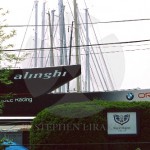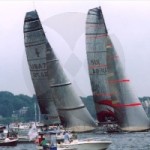I had some pretty pictures to post but this is a thread that should continue
Newport Ocean Sailing Association (NOSA) officials learned late Saturday that three sailors in their Newport to Ensenada offshore race had died in an apparent collision with a large vessel several miles off the coast near the border.
The 37-foot Aegean was reduced to debris that looked “like it had gone through a blender,” a searcher said Sunday after the boat apparently collided with a larger vessel, killing three sailors and leaving a fourth missing. The U.S. Coast Guard, the Mexican navy and civilian vessels scoured the waters off the shore of both countries for the missing sailor before suspending their search Sunday evening. It was California’s second deadly accident this month involving an ocean race.
Race officials said they had few explanations for what may have happened to the Aegean other than it must have collided with a ship like a freighter or tanker that did not see the smaller vessel.
If the smaller boat was bobbing around in light wind, the crew might not have been able to get out of the way of a larger ship, said Rich Roberts, a spokesman for the Newport Ocean Sailing Association, the race organizer. The race goes through shipping lanes and it’s possible for a large ship to hit a sailboat and not even know it, especially at night, Roberts said.
The Coast Guard said conditions were fine for sailing, with good visibility and moderate ocean swells of 6-to-8 feet. Officials had not yet determined the cause of the accident, and would not speculate late Sunday on what ship, if any, might have collided with the sailboat. A race tracking system indicated the Aegean disappeared about 1:30 a.m. PDT (4:30 a.m. EDT) Saturday, he added.
Other yachts near the Coronado Islands in Mexico — four small, mostly uninhabited islands — reported seeing debris Saturday morning. Two of the dead were William Reed Johnson Jr., 57, of Torrance, Calif., and Joseph Lester Stewart, 64, of Bradenton, Fla. The San Diego County Medical Examiner’s office was withholding the name of the third sailor pending notification of relatives. Calls to Johnson’s and Stewart’s homes went unanswered Sunday.
The Aegean is registered to Theo Mavromatis, 49, of Redondo Beach, Calif. The race association didn’t know if he was aboard, but Gary Gilpin at Marina Sailing, which rents out the Aegean when Mavromatis isn’t using it, said the 49-year-old skipper took the yacht out earlier in the week for the competition. Gilpin said Mavromatis, an engineer, was an experienced sailor who had won the Newport to Ensenada race in the past. A woman answering a call at a number listed for Mavromatis declined to answer questions.
Eric Lamb was the first to find debris of the boat — most no larger than six inches — scattered over about two square miles Saturday as he worked safety patrol on the race. He saw a small refrigerator, a white seat cushion and empty containers of yogurt and soy milk. “We pulled a lot of boats off the rocks over the years and boats that hit the rocks, they don’t look like that. This was almost like it had gone through a blender,” said Lamb, 62.
A Coast Guard helicopter circling overhead directed him and a partner to two floating bodies. Both had severe cuts and bruises, and one of them had major head trauma. Two race participants who were in the area at the time the Aegean disappeared said they saw or heard a freighter. Cindy Arosteguy of Oxnard, Calif., remembers hearing on her radio someone say, “Do you see us?” as she saw a tanker about a half-mile away. “I got back on the radio and said, ‘Yes, I see you,'” she said. “It was definitely a freighter.”
In Ensenada, several hundred people held a minute of silence for the victims at an awards ceremony that spilled out in a courtyard from a large white canopy at a hotel that served as race headquarters. Chuck Iverson, commodore of the sailing association, said in an interview that the collision was a “fluke,” noting how common night races are along Mexico’s Baja California coast. “We’re all shocked by this whole event,” he said. The deaths are the first fatalities in the race’s 65 years, the sponsor said. Racing boats are required to use lights at night, Iverson said, although the boats are not inspected unless a competitor suspects a problem and tells race officials. The race attracts sailors of all skills, including some who are new to long distances. “You get world-class sailors and you get first-timers. That’s the good thing about it. … It’s kind of a safety-in-numbers thing,” said Lamb, who has worked safety patrol for eight years.
The Newport Beach Patch website posted a photo of the Aegean’s crew at the start of the race Friday. Four men in royal blue T-shirts are on the deck as the boat cuts through calm waters. A total of 213 boats were registered, and the winner, Robert Lane of Long Beach Yacht Club, finished Saturday in 23 hours, 26 minutes, 40 seconds. A small crowd gathered in the morning fog at an Ensenada marina to watch the remaining boats finish Sunday morning. A notice tacked to a bulletin board alongside the racing times informed spectators of the tragedy.
The deaths come two weeks after five sailors died in the waters off Northern California when their 38-foot yacht was hit by powerful waves, smashed into rocks and capsized during a race. Three sailors survived the wreck and the body of another was quickly recovered. Four remained missing until one body was recovered Thursday.
The accident near the Farallon Islands, about 27 miles west of San Francisco, prompted the Coast Guard to temporarily stop races in ocean waters outside San Francisco Bay. The Coast Guard said the suspension will allow it and the offshore racing community to study the accident and race procedures to determine whether changes are needed to improve safety. U.S. Sailing, the governing body of yacht racing, is leading the safety review, which is expected to be completed within the next month.
In 1979, a freak storm in the Irish Sea led to the deaths of 15 sailors in the Fastnet Race. In the 1998 Sydney to Hobart Race off Australia, a storm with hurricane-force winds struck the fleet in the Bass Strait, sinking several boats and killing six sailors.
Gary Jobson, president of the U.S. Sailing Association, said there have been too many accidents during races in the past year, and that the association is working to make the sport safer. “I’m horrified. I’ve done a lot of sailboat racing and I’ve hit logs in the water, and I’ve seen a man go overboard, but this takes the whole thing to a new level,” Jobson said. “We need to take a step back and take a deep breath with what we’re doing. Something is going wrong here.” Jobson said U.S. Sailing will appoint an independent panel to investigate the Ensenada incident, as it has done in the Farallon Islands accident. Article thanks to the Associated Press.




